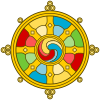| Revision as of 10:32, 2 September 2009 editThe Anomebot2 (talk | contribs)Bots, Extended confirmed users1,042,920 edits Adding geodata: {{coord missing|China}}← Previous edit | Revision as of 11:00, 20 September 2009 edit undoJohn Hill (talk | contribs)Autopatrolled, Extended confirmed users, Pending changes reviewers24,033 edits internal link added to photo caption; portal boxes addedNext edit → | ||
| Line 1: | Line 1: | ||
| {{Tibetan Buddhism}} | {{Tibetan Buddhism}} | ||
| ] | ] street scene, 1993]] | ||
| '''Muru Ningba Monastery''' (rMe ru snying pa) is a small ] monastery located between the larger monasteries of ] and ] in the holy city of ], ]. It was the Lhasa seat of the former State Oracle who had his main residence at ] Monastery.<ref>Dowman, Keith (1998). ''The Power-Places of Central Tibet: The Pilgrim's Guide'', p. 40. Routledge & Kegan Paul, London and New York. ISBN 0-7102-1370-0.</ref> | '''Muru Ningba Monastery''' (rMe ru snying pa) is a small ] monastery located between the larger monasteries of ] and ] in the holy city of ], ]. It was the Lhasa seat of the former State Oracle who had his main residence at ] Monastery.<ref>Dowman, Keith (1998). ''The Power-Places of Central Tibet: The Pilgrim's Guide'', p. 40. Routledge & Kegan Paul, London and New York. ISBN 0-7102-1370-0.</ref> | ||
| Line 17: | Line 17: | ||
| ==Footnotes== | ==Footnotes== | ||
| {{Reflist}} | {{Reflist}} | ||
| {{Buddhism topics}} | |||
| {{Indian Philosophy}} | |||
| {{Buddhism2}} | |||
| {{coord missing|China}} | {{coord missing|China}} | ||
Revision as of 11:00, 20 September 2009
| Part of a series on |
| Tibetan Buddhism |
|---|
 |
| Schools |
Key personalities
|
Teachings
|
| Practices and attainment |
| Major monasteries |
| Institutional roles |
| Festivals |
| Texts |
| Art |
| History and overview |

Muru Ningba Monastery (rMe ru snying pa) is a small Buddhist monastery located between the larger monasteries of Jokhang and Barkhor in the holy city of Lhasa, Tibet. It was the Lhasa seat of the former State Oracle who had his main residence at Nechung Monastery.
It is located immediately behind and east of the Jokhang and may be accessed from the north side of the Barkhor.
It is said that Emperor Songtsän Gampo built the first building here and it is where the great Tibetan scholar, Thonmi Sambhota, finished his work developing the Tibetan alphabet in the first half of the 7th century.
The present building, first constructed during the reign of Ralpacan, is built like an Indian vihara around a courtyard, with the lhakang ('temple', literally 'residence of the deity') to the north and monks quarters on the three other sides.
It became the Lhasa residence of the Nechung Oracle in the 17th century, who was possessed by Pehar in his trances. The lhakang contains a number of fine murals — the central image being that of Guru Rinpoche (Padmasambhava), with images of the five Nyingma Yidam-Protectors and Tseumar and Tamdrin in glass cases around the walls.
On the western side of the gallery upstairs is a place dedicated to Bramze, the Sadhu-Protector of the monastery - his image is to the right of the door.
Footnotes
- Dowman, Keith (1998). The Power-Places of Central Tibet: The Pilgrim's Guide, p. 40. Routledge & Kegan Paul, London and New York. ISBN 0-7102-1370-0.
- Vitali, Roberto (1990). Early Temples of Central Tibet, p. 19. Serindia Publications, London. ISBN 0-906026-25-3.
- Dowman, Keith (1998). The Power-Places of Central Tibet: The Pilgrim's Guide, pp. 48-49. Routledge & Kegan Paul, London and New York. ISBN 0-7102-1370-0.
| Lhasa | ||||||
|---|---|---|---|---|---|---|
| County-level divisions |
|   | ||||
| Towns and villages | ||||||
| Monasteries and palaces |
| |||||
| Other landmarks |
| |||||
| Culture & Life |
| |||||
| Business & Development | ||||||
| Education & Science |
| |||||
| Hotels & Parks | ||||||
| Transport |
| |||||
| Government | ||||||